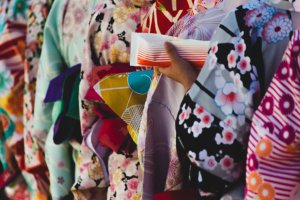Shopping in Japan can be a wonderful experience – from the small 100 yen stores at the local shoutengai to the huge department stores spanning entire train stations and glitzy boulevards of Omotesando or Ginza. This guide aims to draw together all you need to know about spending your yen and filling that spare suitcase.
Overview
Shopping in Japan will be a familiar experience to most foreign visitors but it pays to know in advance how things work. Here we bring together all you need to know, from savings for temporary visitors, how to pay and the in-store experience.
Tax Exemption
At many stores, foreign visitors will be eligible for tax exemption upon showing their passport, which can mean avoiding domestic consumption tax of 8%. Just look for the campaign sign (shown to the right) and read on for more information.
- Locations:
Major department stores and shopping centres will often have tax-free shopping available – just look for the information counter or customer service desk at smaller stores. - Products:
Several product lines are eligible for tax-free shopping. Commodities, including consumer electronics, bags, ornaments, clothing, shoes etc, may be eligible when purchased at the same store on the same day to a total over ¥10,001. Consumables, such as food, beverages, medicine, tobacco, cosmetics etc, can also eligible when purchased at a total of over ¥5,001. - Eligibility:
The tax-free exemption program is geared towards temporary visitors (usually those on a 90 day visa, but in some cases up to 6 months). - Procedure:
This will vary between store, but in all cases you'll need to show your passport. You'll either be able to claim an 8% discount at the time of purchase, or more often than not, be able to claim an 8% rebate on all purchased goods when taking receipts to the tax exemption counter. Either way, check with the store before making any purchases, to determine the procedure and whether they participate in this program. - Savings:
You can save on consumption tax, which is 8% on all consumer goods and can be a significant saving for higher value goods, especially when combined with other discounts.
It's not fairly user-friendly, but JNTO maintain a list of all the retail operators operating this service and showing the logo here, whilst the Japan Shopping Tourism Organisation maintains this directory too.
Payment
Everything you need to know about payment.
Which price is which
In Japan, you'll commonly see the pre-tax price quoted no matter what (on the shelf, in an advert etc). You'll commonly have VAT thrown on top which is 8% as of April 1st 2014, but at larger stores you may be eligible for tax exemption.
Negotiation
Japan does not have the custom negotiating prices when shopping. There are some situations where negotiating is acceptable, but otherwise you should refrain from trying. If you are buying something in imperfect condition, they may on occasion provide a small gift or minimal discount as a way to offset your inconvenience.
Credit cards, cash and IC cards
Increasingly, you'll find yourself being able to use credit cards around Japan but there are still a lot of places that do not accept credit card payments. There also some instances (train ticket machines) where despite the option to pay by credit card seems to exist, in reality only domestic Japanese credit cards are actually accepted.
Japan is still predominantly a cash-based society, so it is worthwhile having enough cash on you to last several days.
In most urban areas, and commercial districts around train stations, many smaller values items can be paid for using IC prepaid cards (like the Suica or PASMO card) – typically at convenience stores but also vending machines!
ATMs
When you need to withdraw more cash, 7 Bank ATMs (at 7-eleven convenience stores or Ito Yokado supermarkets) reliably accept foreign cash and credit cards (such as Visa, Mastercard etc), so it helps to know your nearest 7-eleven (open 24-hours a day) if you need to make withdrawals on the go. Learn more about Japan ATMs.
In-store
Assistance
Sales assistants are generally extremely helpful and polite, and will endeavour to help you no matter what the issue, from checking on stock or helping you make a decision. When it comes to something technical, staff are usually very well-informed and will do their best to help you. If they have the resource, they'll likely try to find an English-speaking member of staff to help if one is available. You can always use our shopping survival phrases too.
Trying on clothes
Most stores have fitting rooms available although it is customary to ask a store assistant/clerk before you wish to try on, who are usually in the vicinity. Often you'll be expected to remove your shoes before entering a fitting room so bear this in mind – you may find the staff arrange your shoes tidily for you before you exit which is a nice novelty!
Sales
Seasonal sales are held throughout the year, with sales periods announced and publicised well in advance. A lot of clothing stores will also announce limited "time sales" (タイムセール), often offering an additional 10-15% on top of existing store prices (sale goods or otherwise) at some point throughout the afternoon.
Souvenirs and Gift-wrapping
No guide on shopping in Japan would likely be complete without mention of souvenirs, or omiyage. The souvenir industry is huge in Japan and you'll be spoilt for choice in almost any region. Regional snacks are fairly popular as domestic gifts but may not suit long haul transit back home.
A great many shops offer gift-wrapping services. Often this will be free, but may incur a small additional charge at some stores.




























